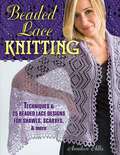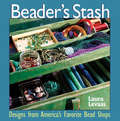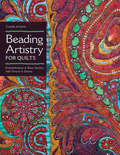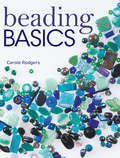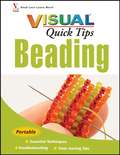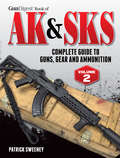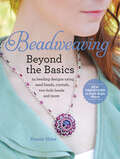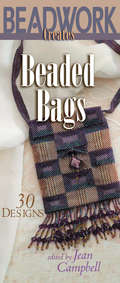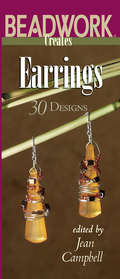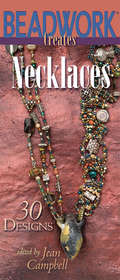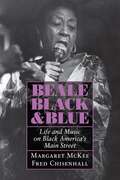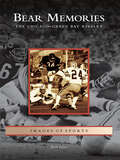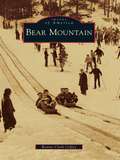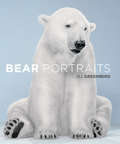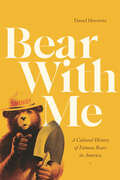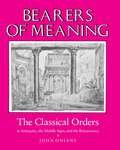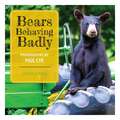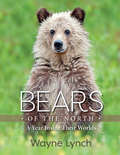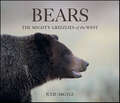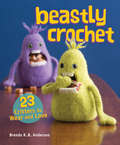- Table View
- List View
Beaded Lace Knitting
by Anniken AllisCreate delicate knitted lace fashions, and then kick them up a notch with beautiful beaded embellishments, led by lace expert Anniken Allis.
Beaders Stash: Designs from America's Favorite Bead Shop
by Laura LevaasThe finest independent bead shops across the United States and Canada open their doors and their bead boxes in this showcase of materials and techniques to inspire beaders of all stripes. Forty projects mix insider tips with inventive arrangements, employing techniques from stringing and weaving to bead embroidery, wire wrapping, and soldering. Beginners will find an array of rewarding projects and advanced beaders will delight in the original ideas, such as a tic-tac-toe art deco piece, beaded lanterns, a fuzzy felted bead bracelet, a vintage-inspired picture pendant necklace, a spiritual talisman lariat and bracelet, and a unique mosaic bead tray. An instructive Beading 101 section, an illustrated techniques glossary, and a bead shop directory round out the book, making this collection a staple of creative beadwork.
Beading Artistry for Quilts: Embellishments & Basic Stitches, Add Texture & Drama
by Thom Atkins“I love patchwork, beadwork, and I love handwork . . . The instructions are easy to follow and it’s nothing short of divine inspiration for me.” —Mark Lipinski, editor, Quilter’s Home magazineUse beads and simple stitches to create magnificent texture, dimension, and lifelike details on any quilt. Award-winning quilter, Thom Atkins, teaches you everything you need to know about the best supplies and techniques to get breathtaking results . . . plus there’s a bonus tutorial on how to create a beaded bezel. Dozens of show-stopping images throughout the book illustrate the unlimited possibilities for designing your own spectacular beaded quilt. Whether you like to make traditional or art quilts, this book will help you take your fabric embellishing to a whole new level.“I have always used a lot of beads and sequins in my work and this book is bead heaven! . . . This is a visual feast and certainly one book I will definitely include in my collection.” —Fabrications Quilting for You“Packed with lots of information to set you on your embellishing journey . . . Even if you don’t think beading is for you, the beautiful photos you see as you leaf through the pages will have you reaching for the book for color and design inspiration.” —Down Under Textiles“Will inspire you to create your own beaded masterpiece.” —Quilter’s Delight
Beading Basics
by Carole RodgersDiscover the basics of beading and beyond! If you've been tempted by the beauty of beaded jewelry and home decorating pieces, but second guessed your abilities to learn the skills needed to create such tantalizing works, fear no more!Beading Basicsreveals all that's necessary for creating everything from a simple single-strand necklace to a more intricate netting stitch woven wind bottle covers. You'll discover: Essential information for choosing the right beads, supplies and tools, plus tips and techniques for working with wire, weaving on a loom and creating various woven chains. Easy-to-follow instructions with more than 175 how-to illustrations and 230 beautiful photographs showing every detail needed to create 40 gorgeous projects. An inspirational gallery of designs featuring the works of 11 of today's top beading artists. Beading Basicsis the one resource you need to get you on the path to becoming a talented bead artist.
Beading VISUAL Quick Tips
by Chris Franchetti MichaelsExpert tips and tricks for making beaded jewelry are at your fingertips-anywhere you go. Beading VISUAL Quick Tips has the answers you need. With detailed color photos and concise instructions, it shows you how to make beautiful beaded jewelry using the hottest beading supplies and beading techniques: stringing and finishing beading wire, cord, thread, and ribbon; using head and eye pins; knotting between beads; creating beaded knots and lace; making tassels and fringe; weaving with the peyote stitch; beading with macrame knots and braids; and more.
Beadweaving Beyond the Basics: 24 Beading Designs Using Seed Beads, Crystals, Two-hole Beads and More
by Kassie ShawTake your beadweaving designs to the next level!Explore an inspired approach to weaving beaded jewelry with Beadweaving Beyond the Basics. Experiment with color and shape with these 24 gorgeous designs from beadweaving teacher and Beadwork contributor Kassie Shaw. In addition to showcasing classic stitches, including Herringbone, Peyote and St. Petersburg, these designs incorporate Kassie's innovative variations on Right Angle Weave--Double Diamond Right Angle Weave, Faux Right Angle Weave and Layered Right Angle Weave. In-depth primers on these new approaches will get you started right away, and the tips for left-handed beaders makes sure everyone can try these designs with ease!Inside, you'll discover a full range of bead shapes such as seed beads, two-hole beads, bicone crystals, bugle beads and lentils, to get the shapes and effects you want, then try them in multiple colorways to create head-turning creations. With your new beadweaving skills, the possibilities are endless!Beadweaving Beyond the Basics is a whole new world of artistic expression!
Beadweaving Beyond the Basics: 24 Beading Designs Using Seed Beads, Crystals, Two-hole Beads and More
by Kassie ShawTake your beadweaving designs to the next level!Explore an inspired approach to weaving beaded jewelry with Beadweaving Beyond the Basics. Experiment with color and shape with these 24 gorgeous designs from beadweaving teacher and Beadwork contributor Kassie Shaw. In addition to showcasing classic stitches, including Herringbone, Peyote and St. Petersburg, these designs incorporate Kassie's innovative variations on Right Angle Weave--Double Diamond Right Angle Weave, Faux Right Angle Weave and Layered Right Angle Weave. In-depth primers on these new approaches will get you started right away, and the tips for left-handed beaders makes sure everyone can try these designs with ease!Inside, you'll discover a full range of bead shapes such as seed beads, two-hole beads, bicone crystals, bugle beads and lentils, to get the shapes and effects you want, then try them in multiple colorways to create head-turning creations. With your new beadweaving skills, the possibilities are endless!Beadweaving Beyond the Basics is a whole new world of artistic expression!
Beadwork Creates Beaded Bags: 30 Designs
by Jean CampbellThese designs for a wide variety of bags from the beading world's top designers will amaze beginners as well as advanced beadworkers. These 30 projects include clutches, drawstring purses, wrist bags, amulet bags, and even a market bag. Featured are a variety of techniques leading to bags that are not only beautiful, but can often be completed in an evening or weekend, providing instant gratification. Included are tips to help start each project and clear demonstrations of each stitch used in the book. Each project includes information about the designer, giving a feel for the people in and the bead buzz surrounding this interesting and accessible community.
Beadwork Creates Beaded Rings (Beadwork Creates Ser.)
by Jean CampbellBeaders learn how to create bold and original finger jewelry quickly and easily with this guide to beadwork. Spectacular beading projects created by prominent designers are provided along with beautiful photography and clear step-by-step instructions. The gorgeous variety of stylish rings include flashy rhinestone coils and modest pattered tubes, flowers for the hand, crystal domes that catch the light, leopard skin and sea urchin rings, and a ring for one's chakra. The techniques used to create these fun and easy rings range from simple netting to peyote stitch.
Beadwork Creates Bracelets: 30 Designs (Beadwork Creates Ser.)
by Jean CampbellBeginners and seasoned beadworkers alike will be thrilled to discover the 30 fun and stylish bracelets in this creative guide to beading jewelry. Clear, logical directions and easy-to-follow illustrations accompany each project, from simple bead stringing and wire working to more complex macramé, crochet, and off-loom weaving techniques. The flexible binding allows the book to lie flat while beaders work on hand-busying projects.
Beadwork Creates Earrings: 30 Designs (Beadwork Creates Ser.)
by Jean CampbellAn enticing spectrum of designs - simple drops with sparkling vintage beads, flashy fringe inspired by the 1970s, free-form doodles, tasteful tassels, and delicate crosses made with Russian techniques - are featured in the projects included in this guide that focuses solely on the creation of earrings. Using a variety of popular beads, a potpourri of beading methods such as basic stringing, edging variations, netting, peyote stitch, right-angle weave, and wirework, and clear illustrations, this how-to shows beginners and those with more advanced skills how to simply and quickly create an assortment of drop, hoop, and chandelier earrings.
Beadwork Creates Necklaces: 30 Designs (Beadwork Creates Ser.)
by Jean CampbellBeaders and jewelry-makers will love the 30 incredible projects for dazzling, draping, hand-beaded necklaces in this creative resource. From easy to advanced instruction, readers will find it exciting to create these beautiful designs with their own hands. Step-by-step directions are accompanied by simple illustrations, allowing beaders to master even the more complicated techniques.
Beale Black and Blue: Life and Music on Black America's Main Street
by Margaret McKee Fred ChisenhallW. C. Handy, Furry Lewis, Booker White, Lillie May Glover, Roosevelt Sykes, Arthur Crudup, B. B. King, Bobby Blue Bland, Muddy Waters -- these and other musicians, singers, and songwriters, including the young Elvis Presley, eventually went to Beale Street in Memphis, Tennessee, to learn, improve, and practice their art. "To Handy and untold other blacks, Beale became as much a symbol of escape from black despair as Harriet Tubman's underground railroad," says Margaret McKee and Fred Chisenhall. They present Beale as a living microcosm of determination, survival, and change -- from its early days as a raucous haven for gamblers and grafters and as a black show business center to its present-day languishing. Choosing the former newspaper columnist, disc jockey, and schoolteacher Nat. D. Williams, as their main authority for the first part of this volume -- the street's history -- the authors have selected an individual with wisdom, perspective, and a distinctive voice that speaks from a lifetime of experience on Beale. His radio show on WDIA, "Tan Town Jamboree," was heard by thirteen-year-old Elvis Presley. Nat D. said, "We had a boast that if you made it on Beale Street, you can make it anywhere. And Elvis Presley made it on Beale first." Another Beale Streeter recalls, "He got that shaking, that wiggle, from Charlie Burse -- Ukulele Ike we called him -- right there at the Gray Mule on Beale."
Beale Street (Images of America)
by Dr Beverly Bond Dr Janann ShermanOnce celebrated as the Main Street of Negro America," Beale Street has a long and vibrant history. In the early 20th century, the 15-block neighborhood supported a collection of hotels, pool halls, saloons, banks, barber shops, pharmacies, dry goods stores, theaters, gambling dens, jewelers, fraternal clubs, churches, entertainment agencies, beauty salons, pawn shops, blues halls, and juke joints. Above the street-level storefronts were offices of African American business and professional men: dentists, doctors, undertakers, photographers, teachers, realtors, and insurance brokers. By mid-century, following the social strife and urban renewal projects of the 1960s and 1970s, little remained of the original neighborhood. Those buildings spared by the bulldozers were boarded up and falling down. In the nick of time, in the 1980s, the city realized the area's potential as a tourist attraction. New bars, restaurants, and entertainment venues opened along the remaining three-block strip, providing a mecca for those seeking to recapture the magic of Beale Street."
Bear Creek Valley (Images of America)
by Jeff Mcneish Carbon County Historical SocietyMemories of Montana's Bear Creek Valley flicker briefly to life each February on the anniversary of its darkest day. It is remembered as the site of Montana's worst coal mining accident, which claimed the lives of 75 miners, but the valley was so much more. For decades it was Montana's "coal basket," housing two towns, dozens of coal mines, and a population equaling that of neighboring Red Lodge. Businesses included a movie theater, dry goods store, grocery stores, hotels, hospitals, butchers, banks, bars, and union halls, all serving residents with pan-European origins. Its schools produced championship sports teams and community leaders. Gone, but not forgotten, Bear Creek Valley lives on in this book.
Bear Memories: The Chicago-Green Bay Rivalry (Images of Sports)
by Beth Gorr"Halas would provide food according to how we had fared against the Packers. If we won, it was steaks for everybody. But if we lost, we were lucky to be served hamburgers."--Harlan Hill, 1950s"I didn't have any particular grievance with any of the Packer players, I just wanted to beat them all."--Hall of Famer Doug Atkins, 1960s"Doug Buffone took me aside to tell me about Green Bay games . . . to set me straight about the importance of the rivalry. It definitely was not a game to be taken for granted."--Brian Baschnagel, 1970s"Each year at the start of the season, fans we'd meet would just have the one request--please beat Green Bay."--Jim Flanigan, 1990s
Bear Mountain
by Ronnie Clark CoffeyBear Mountain, once home to Native Americans and early settlers, had evolved by the 20th century into one of the nation's most outstanding public parks. Threatened by quarrying operations and the relocation of Sing Sing Prison, this integral section of the Hudson Highlands was saved by the combined efforts of local citizens and the Palisades Interstate Park Commission. Graced by a deep, picturesque lake at the foot of the mountain and accessible by riverboat, train, and automobile, Bear Mountain State Park became a playground for New York City residents. Visionary park management enabled the park to expand, encompassing nature exhibits, a zoo, camps, and restaurants. It continues to be a year-round recreation center featuring hiking, boating, swimming, and cross-country skiing.
Bear Portraits
by Jill GreenbergA top celebrity portrait photographer, Jill Greenberg has a unique ability to coax powerful emotions out of her subjects - whether human or animal. Her portraits of bears, collected here for the first time, surprise and engage. We encounter cubs as cute as a child's Teddy, grizzlies that look like they might swallow you whole, and Polar bears seated in Sphinx-like tranquility. Full-grown brown bears, grizzlies, black bears, Polar bears, and bear cubs are photographed on location against a portrait backdrop. The poses and facial expressions are at turns oddly comedic, pensive, terrifying, and sometimes unexpectedly human. Alive with Greenberg's signature lighting and seen through the unique perspective of her lens, these startling bear portraits bring us face to face with our fears and fantasies.Â
Bear With Me: A Cultural History of Famous Bears in America
by Daniel HorowitzFrom teddy bears and Winnie-the-Pooh to Smokey Bear, Yogi Bear, and Cocaine Bear, American popular culture has been fascinated with real and fictional bears for more than two centuries. Bears are ubiquitous, appearing in advertisements, as logos for sports teams, and as central characters in children’s books, cartoons, movies, and video games. In Bear With Me, Daniel Horowitz presents a vibrant history of the pedestrian and celebrity bears who have captured our imaginations and infiltrated our everyday lives. He shows that bears’ ability to represent and evoke both terror and comfort makes them well-suited for their omnipresence. Today, cultural depictions of bears largely encompass examples of human-bear relationships, reciprocity, and emotional engagement. Reminders that climate change threatens the lives of polar bears engender feelings of empathy, while news of bear attacks drives us to fascinated fear. Whether examining the subculture of gay bears or the deadly consequences of anthropomorphizing animals, Horowitz charts the complexities and depth of American culture’s unique and enduring relationship with bears.
Beardsley's Le Morte Darthur: Selected Illustrations
by Aubrey BeardsleyBeardsley's illustrations for the Dent edition of the great Thomas Malory classic made him famous virtually overnight. This volume contains a rich selection of those splendid drawings, including floral and foliated openings, fauns and satyrs, initials, ornaments, and much more. Characters from Arthurian legend are portrayed in 62 splendid full-page black-and-white illustrations.
Bearers of Meaning: The Classical Orders in Antiquity, the Middle Ages, and the Renaissance
by John OniansFor all those interested in the relationship between ideas and the built environment, John Onians provides a lively illustrated account of the range of meanings that Western culture has assigned to the Classical orders. Onians shows that during the 2,000 years from their first appearance in ancient Greece through their codification in Renaissance Italy, the orders--the columns and capitals known as Doric, Ionic, Corinthian, Tuscan, and Composite--were made to serve expressive purposes, engaging the viewer in a continuing visual dialogue.
Bears Behaving Badly
by John McDonaldBears (particularly black bears) by nature are elusive and difficult to see in the wild; yet they are immensely popular, perhaps because they are surprisingly human-looking, though their dense fur and seemingly clumsy gait often lead them to be compared with shaggy, bumbling clowns. Well, the bears in this little gift book have had enough. They&’re here to set the record straight. 75-100 color photos capture bears just doing their thing and being bears; and short, pithy phrases tell you just what these bears would say if they could only talk.
Bears of the North: A Year Inside Their Worlds
by Wayne LynchAn unprecedented visual and scientific journey into the secret world of bears.In Bears of the North, renowned wildlife photographer, naturalist, and bestselling author Wayne Lynch offers us a work of scintillating science and stunning beauty. Following polar bears, brown bears, and American and Asiatic black bears through the seasons, this journey is an insider's view of hibernation's mysteries and the birth of cubs in winter; the mating rituals and voracious appetites of spring; hunting, fishing, and encounters with neighbors during summer; and the feeding frenzy and exuberant play of autumn. Dispelling the stereotypes and untruths—but none of the magic—surrounding these magnificent animals, Lynch comments on the latest scientific discoveries related to the biology, behavior, and ecology of bears. He describes how satellite telemetry has revealed the purpose behind the meanderings of bears and the great distances they sometimes cover on land and in water. He also shows how DNA analysis can teach us about the relatedness of bears within a population, even revealing the identity of a particular cub's father. Taking us out into the wilds of the tundra and forests to share his firsthand observations of the marvelous bears of the Northern Hemisphere, Lynch describes their survival strategies and the threats they face from habitat fragmentation and global climate change. Lynch's fascinating narrative is enhanced by over 150 gorgeous, original color photographs that capture bears in their habitats, including appearances of the elusive moon bear, fierce polar bear battles, and rare images of mothers' intimate moments with their cubs. Informed by Lynch's nearly forty years of experience observing and photographing bears in the wild, and aided by sophisticated digital photo technologies, Bears of the North is an unrivaled collection of enthralling and informative portraits of bears in their natural environments.
Bears: The Mighty Grizzlies of the West
by Julie ArgyleThe mighty North American brown bear, most often referred to as the grizzly, is an iconic symbol of power and strength. Mostly found in the Western United States and Canada, the still-endangered bruin has made strides into a tenuous sustainability. The strikingly beautiful photography, and the essay woven through the pages of Bears: The Mighty Grizzlies of the West, showcases this beautiful, smart, and incredible species. Julie Argyle explores their behavior, their family dynamics, and what it means to be a grizzly in the wilderness of the greater Yellowstone area. She includes stories about individual bears: Raspberry and Snow, The Beryl Sow, The Obsidian Sow, Snaggletooth, and 791 (a famous boar), and looks at the issues of increasing conflicts between humans and the grizzlies and what the future holds for them.
Beastly Crochet: 23 Critters to Wear and Love
by Brenda K.B. AndersonJoin author Brenda Anderson in her fascination with scary-cute creatures to crochet. In this collection Brenda presents 23 accessories and toys, featuring furry monsters, carnivorous plants, killer robots, and menacing tiki figures. While there are some literal monsters in the bunch--toys and amigurumi--a majority of projects are wearable accessories and garments. Some projects, such as a robot-themed intarsia blanky, are aimed specifically at children, while many others are for adults and teens who want to have a little fun. Brenda shows how to tackle all the sewing and appliqué techniques required in her patterns, including how to install zippers, as well as subtle tricks for achieving personality in your critters with a section on "The Principles of Cuteness." Beastly Crochet is a book that is as fun to read as it is to crochet from!
